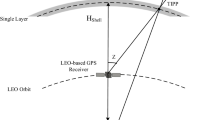Abstract
TerraSAR-X (TSX), a high-resolution interferometric Synthetic Aperture Radar (SAR) mission from DLR (German Aerospace Center, Deutsches Zentrum für Luft-und Raumfahrt), was successfully launched into orbit on June 15, 2007. It includes a dual-frequency GPS receiver called IGOR (Integrated GPS Occultation Receiver), which is a heritage NASA/JPL BlackJack receiver. The software for the TSX IGOR receiver was specially-modified software developed at UT/CSR. This software was upgraded to provide enhanced occultation capabilities. This paper describes total electron content (TEC) estimation using simulation data and onboard GPS data of TerraSAR-X. The simulated GPS data were collected using the IGOR Engineering Model (EM) in the laboratory and the onboard GPS data were collected from the IGOR Flight Model (FM) on TSX. To estimate vertical total electron content (vTEC) for the simulation data, inter-frequency biases (IFB) were estimated using the “carrier to code leveling process.” For the onboard GPS data, IFBs of GPS satellites were retrieved from the navigation message and applied to the measurements.
Similar content being viewed by others
References
LANYI, G. E. and ROTH, T. “A Comparison of Mapped and Measured Total Ionospheric Electron Content using Global Positioning System and Beacon Satellite Observations,” Radio Science, Vol. 23, No. 4, 1988, pp. 483–492.
MANUCCI, A. J., WILSON, B.D., YUAN, D.N., HO, C. M., LINDQWISTER, U. J., and RUNGE, T. F. “A Global Mapping Technique for GPS-Derived Ionospheric Total Electron-Content for GPS-Derived Ionospheric Total Electron-Content Measurements,” Radio Science, Vol. 33, No. 3, 1998, pp. 565–582.
MANNUCCI, A. J., TSURUTANI, B. T., IIJIMA, B. A., KOMJATHY, A., SAITO, A., GONZALEZ, W.D., GUARNIERI, F. L., KOZYRA, J.U., and SKOUG, R. “Dayside global ionospheric response to the major interplanetary events of October 29-30, 2003 ‘Halloween Storms,’” Geophysical Research Letters, Vol. 32, 2005, L12S02, doi:10.1029/2004GL021467.
HOFFMANN-WELLENHOF, B., LICHTENEGGER, H., and COLLINS, J. Global Positioning System: Theory and Practice, Springer-Verlag, Fourth revised edition, 1997, pp. 102.
WILSON, B. and MANNUCCI, A. “Extracting Ionospheric Measurements from GPS in the Presence of Anti-Spoofing,” Proceedings of the 7th International Technical Meeting of the Satellite Division of the Institute of Navigation, 1994, pp. 1599–1608.
CIRAOLO, LO., AZPILICUETA, F., BRUNINI, C., MEZA, A., and RADICELLA, S.M. “Calibration Errors on Experimental Slant Total Electron Content (TEC) Determined with GPS,” Journal of Geodesy, Vol. 81, No. 2, 2007, pp. 111–120
BRAASCH, M. “Multi-Path Effects,” in Global Positioning System: Theory and Applications, vol 1. Progress in Astronautics and Aeronautics, American Institute of Aeronautics and Astronautics, Parkinson, B.W. and Spilker, J.J. (eds), 1996, pp 547–568.
MANNUCCI, A. J., WILSON, B.D., and EDWARDS, C.D. “A New Method for Monitoring the Earth Ionospheric Total Electron Content Using the GPS Global Network,” Proceedings of the 6th International Technical Meeting of the Satellite Division of the Institute of Navigation, 1993, pp.1323–1332.
MONTENBRUCK, O., WILLIAMS, J., WANG, T., and LIGHTSEY, G. “Preflight Validation of the IGOR GPS Receiver for TerraSAR-X,” GTN-TST-0200, Version 1.2, 2005; Deutsches Zentrum für Luft-und Raumfahrt, Oberpfaffenhofen.
BRUNINI, C., MEZA, A., and BOSCH, W. “Temporal and Spatial Variability of the Bias Between TOPEX-and GPS-Derived Total Electron Content,” Journal Geodesy, Vol. 79, DOI 10.1007/s00190-005-0448-z.
ZARCHAN, PAUL(Editor-in-Chief), edited by Parkinson, B.W. and Spilker J. J. (1996), “Global Positioning System: Theory and Applications,” Vol 1. Progress in Astronautics and Aeronautics, American Institute of Aeronautics and Astronautics, 1996.
HOBIGER, T., KONDO, T., and SCHUH, H. “VLBI as a Tool to Probe the Ionosphere,” Proceedings of the 4th IVS General Meeting, Concepcion, Chile, 9-11 January, 2006.
ARIKAN, F., ARIKAN, O., and EROL, C. B. “Regularized Estimation of TEC from GPS Data for Certain Midlatitude Stations and Comparison with the IRI Model,” Advances in Space Research, Vol. 39, Issue 5, 2007, pp. 867–874.
Author information
Authors and Affiliations
Corresponding author
Rights and permissions
About this article
Cite this article
Choi, KR., Lightsey, E.G. Estimation of total electron content (TEC) using spaceborne GPS measurements. J of Astronaut Sci 56, 375–399 (2008). https://doi.org/10.1007/BF03256559
Published:
Issue Date:
DOI: https://doi.org/10.1007/BF03256559




